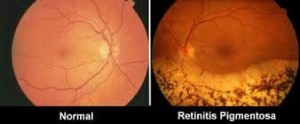Retinitis Pigmentosa 视网膜色素变性
Retinitis Pigmentosa at Different Stages from mild to moderate to severe
Retinitis Pigmentosa is one of the most common forms of inherited retinal degeneration. The retina is the layer of tissue at the back of the inner eye. The photoreceptor or light cells called Rods and Cones within the retina capture and convert images to nerve signals and send them to the brain through optic nerve.
With RP, the rods cells that are responsible for peripheral and night vision are damaged by genetic mutations and deteriorate.Rods are usually affected first. Because rods are concentrated in the outer portions of the retina and are triggered by dim light, their degeneration affects peripheral and night vision. At early stage, patients notice difficulty seeing in low light or at night and lose peripheral vision over time. In some patients, RP is mild while in others, it can lead to blindness. When the more centrally located cones – responsible for color and sharp central vision – become involved, the loss is in color perception and central vision.
RP is typically diagnosed in adolescents and young adults. It is usually discovered when the patient complains about not being able to see at night. It is a progressive disorder. The rate of progression and degree of visual loss varies from person to person. Most people with RP experience loss of their peripheral vision but maintain their central vision until late in the disease.
Some of common symptoms:
- Night blindness (nyctalopia);
- Tunnel vision (no peripheral vision);
- Peripheral vision (no central vision);
- Aversion to glare;
- Slow adjustment from dark to light environments and vice versa;
- Blurry vision;
- Poor color separation; and
- Extreme tiredness.
3 common stages of RP:
- Decreased vision at night or in low light (in mild cases)
- Loss of peripheral vision, causing “tunnel vision”(in moderate or severe cases)
- Also Loss of central vision (in advanced cases)
The main risk factor is family history of RP. It affects about 100,000 people in North America. And that number is growing. This degeneration is progressive and has no known cure.
Other inherited diseases also share some of the clinical symptoms of RP. The most common one is Usher Syndrome, where hearing and vision are both affected. And another one is Leber Congenital Amaurosis, a rare inherited eye disease, a severe dystrophy of the retina that appears at birth or in the first few months of life. It’s one of the most common causes of blindness in children.
Micro Acupuncture treatment has been helping many RP patients to increase their vision fields, prevent or slow their vision loss or at least halt the progression of the disease.
Result from Micro acupuncture Treatment with Retinitis Pigmentosa:
Patient: 49 YEARS OLD, FEMALE
Left eye;
Before treatment 8 months after 26 months after
Right eye;
Before treatment 8 months after 26 months after




